Power supply using solar panels: do-it-yourself system assembly. Solar power plants - autonomous power supply to a country house from solar panels.
Many amenities in residential and domestic buildings depend on electricity. However, power outages are not uncommon in cities and suburbs. For settlements remote from civilization, the problem is even more urgent - sometimes it is simply impossible to install an electrical network there. In such cases, the issue of independent current generation becomes acute.
Autonomous power supply can provide buildings with energy in the required quantity. In this case there is no short circuits, voltage stability is maintained, emergency situations practically do not occur. Connecting such equipment is not as complicated as those dependent on general networks and often pays for itself in a faster time.
Choosing a personal source of electricity - a responsible occupation that requires studying the nuances. This is especially true when the system is made by hand.
There are not many alternative resources, but each of them has its own pros and cons for certain situations.
What types of autonomous power supply systems are there?
All sources of independent electricity are divided into generators, batteries and solar panels.
- Fuel
 They operate by burning diesel, gasoline, coal, gas or other substances.
They operate by burning diesel, gasoline, coal, gas or other substances.
- Fuel-free
Use wind energy to convert into electricity. This also includes hydropower, based on water abstraction, and geothermal sources.
They act by absorbing and storing heat from the sun's rays.
Batteries
They charge themselves from electricity and, in its absence, give away the accumulated reserve.
How to choose for an apartment, house, cottage?
Choose the right one autonomous power supply at home is not so difficult if you take into account some parameters.
The first thing you need to rely on is number and nature of systems consuming energy. Typically, the list of such systems includes air conditioning, heating, and pumping water supply from a well. It is also necessary to take into account the number of frequently used household electrical appliances and refrigeration equipment. All of the above requires uninterruptible power supply, which any independent source can provide.
The second stage of selection will be the calculation of the total power. The consumption indicators of each device are added together. The final autonomous power supply for a country house, cottage or apartment should exceed the amount received by 20-30%.
The type of system being planned is also influenced by the role assigned to it: full supply or backup power. Not all sources can supply recycled electricity for a long time without depending on external factors.
The allocated budget will determine the high cost of the system, its manufacturer, or give rise to the idea of making it yourself.
With fuel-free generators, you will have to pay attention to the surrounding landscape and climate.
The ideal option is to choose two alternative recharges at once different types. Then there will be a safety net for all occasions. Experts advise keeping a generator running on combustible fuel (with a supply of fuel itself) and one of the inverters that absorb the natural forces of wind, sun, water or steam. The separate use of batteries is rarely practiced due to the quickly consumed resource and the impossibility of recharging without direct electricity. However, as another backup option, this is quite suitable for an apartment or private house with a centralized network.
Detailed story about the finished kit
Pros and cons of AE sources
 Such generators require a considerable supply of fuel, which must be constantly replenished at your own expense. Most often, this type is used for mixed power generation in an uninterrupted mode, when the generator is activated when the main network “falls asleep.” In cases using only a generator, it is required to have at least 2 units of equipment to avoid overloads by alternating switching on.
Such generators require a considerable supply of fuel, which must be constantly replenished at your own expense. Most often, this type is used for mixed power generation in an uninterrupted mode, when the generator is activated when the main network “falls asleep.” In cases using only a generator, it is required to have at least 2 units of equipment to avoid overloads by alternating switching on.
A good option for combining with other sources, if you don’t mind the bulky size. In micro modifications, only hydraulic turbines exist. All types are considered environmentally friendly, but require connection additional equipment. Wind models are dependent on air flow speed (at least 14 km/h).
 The most environmentally friendly way to get . Operating batteries can not only provide any typical building with power, but also generate excess power. In practice, they have a large area, often cover entire roofs or walls for high-quality power and require additional equipment. The entire system can even occupy a separate room of about 5-6 sq.m (not counting the solar panels). Dependent on the landscape climatic conditions, the ratio of the number of cloudy and sunny days.
The most environmentally friendly way to get . Operating batteries can not only provide any typical building with power, but also generate excess power. In practice, they have a large area, often cover entire roofs or walls for high-quality power and require additional equipment. The entire system can even occupy a separate room of about 5-6 sq.m (not counting the solar panels). Dependent on the landscape climatic conditions, the ratio of the number of cloudy and sunny days.
Solar panels shown in video
Batteries
Suitable for emergency power supply only. They are not able to work for a long time without recharge. Most models are capable of delivering charge only in the presence of an inverter to increase the voltage (for example, from 12 to 220V).
Types of energy and their solutions
Basic sources of autonomous energy supply are renewable. They are safe for people nearby and environment. Each type of energy has its own operating principle and requires equipment of a unique design.
 Suitable even for areas with little sun. they take air through turbines installed on 3-6 meter towers with approximately 3 cm in diameter. For urban areas, the height of the tower increases and becomes at least 10 m. Such a long free section is necessary to overcome obstacles from neighboring buildings. For a private home, the installation process is less difficult. The use of a wind turbine may require written permission from the governing authorities. The reasons for this are the noise they produce, their bulky appearance and the ability to interfere with bird migrations.
Suitable even for areas with little sun. they take air through turbines installed on 3-6 meter towers with approximately 3 cm in diameter. For urban areas, the height of the tower increases and becomes at least 10 m. Such a long free section is necessary to overcome obstacles from neighboring buildings. For a private home, the installation process is less difficult. The use of a wind turbine may require written permission from the governing authorities. The reasons for this are the noise they produce, their bulky appearance and the ability to interfere with bird migrations.
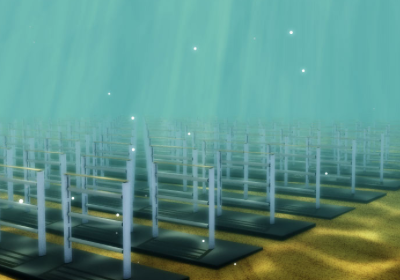 The concept is feasible for houses with nearby rivers or lakes. The intake is carried out by a single turbine or a group of them (often of large length). The large-scale option is beneficial when used collectively (for example, by an entire village or several neighboring private houses). The microform is suitable for an isolated family living directly on the shore. Scales smaller than dams are not considered environmentally destructive and therefore do not require a permit (exceptions are protected areas and local regulations).
The concept is feasible for houses with nearby rivers or lakes. The intake is carried out by a single turbine or a group of them (often of large length). The large-scale option is beneficial when used collectively (for example, by an entire village or several neighboring private houses). The microform is suitable for an isolated family living directly on the shore. Scales smaller than dams are not considered environmentally destructive and therefore do not require a permit (exceptions are protected areas and local regulations).
Sun
Solar energy can be obtained in two ways. The first method uses photovoltaic cells. The basis is the principle of absorption of rays by mirrors. The light is refracted at a certain angle and heats the liquid of the system. The second option involves the principle of converting heat into alternating current through photo cells. They can be portable or placed on rooftops.
Solar power is most suitable for arid regions with hot climates, but can be used anywhere. Maximum productivity is achieved by installing the panels at an angle of incidence of sunlight of 20-50 degrees. Does not require operating permits.
Solar solution demonstrated in video
 Geothermal energy is obtained after processing steam and hot water at a level below the ground. When reinjected, condensate is used, which makes the source more stable. It is quite difficult to use geothermal reservoirs for a private home. Their operation is limited by the time of complete cooling. For a large scale, the principle is easier to implement - a system of a drill, pumps and a generator will process electricity more productively. A drilling permit may be required.
Geothermal energy is obtained after processing steam and hot water at a level below the ground. When reinjected, condensate is used, which makes the source more stable. It is quite difficult to use geothermal reservoirs for a private home. Their operation is limited by the time of complete cooling. For a large scale, the principle is easier to implement - a system of a drill, pumps and a generator will process electricity more productively. A drilling permit may be required.
Biomass
Biomass energy is produced by burning biological material - cake, straw, natural gas, manure, oils, wood, etc. For private houses and summer cottages, this method is acceptable, but not very profitable. Fuel is expensive and needs to be constantly replenished. Gas generators are also not cheap. In addition, the method is characterized high level emissions of sulfur, nitrogen, carbon footprint into the atmosphere during combustion.
A biomass solution will only become profitable when using waste or secondary sources: propane, humus, methane. Hybrid diesel and gas system – more the best option from an economic point of view.
Profitable or not?
The benefits of autonomous energy supply resources for personal use are evident when only high-quality equipment is installed.
Cheap, flimsy kits can break before they're worth half their cost. If the design, calculations, assembly and installation are carried out according to the rules, the system will demonstrate its pros:
- absence of any social norms for electricity consumption;
- safety for systems and devices due to the absence of voltage surges;
- confidence in the quality and quantity of planned energy;
- long service life;
- independence from tariff increases;
- availability of resources even in case of local accidents at substations.
Despite all the benefits, a repulsive factor may be the need to regularly clean the complex and sometimes replace elements.
Example of a ready-made solution
Making the system yourself
For use inside an apartment or in a country house in emergency situations, you can assemble a battery with your own hands. Several household batteries are combined in parallel, connected to a charger, and an inverter is installed. While the centralized power supply is operating, electricity is stored in batteries plugged into the outlet. When the current disappears, the inverter supplies it to the wiring. Can be used as a portable device.
To create food for an entire house with your own hands on an ongoing or long-term basis will require a more serious approach. Here it is preferable to equip the room as a boiler room, where the base of the equipment will be located. You will need a generator, powerful batteries (several car batteries), boilers, inverters, several solar panels for the selected system. If you have certain knowledge, such work is worth the candle and will be cheaper than many ready-made installations.
However risk of making a calculation error and connections are also not small.
Conclusion
The problem of autonomous energy supply is relevant for many residential areas without developed infrastructure. In most cases, this approach helps the environment and can save a lot in the long run. Money. The choice of a specific system depends on the needs of the home, available natural resources and planned expenses.
The feasibility of use is determined by personal views, but increases with the reserve role of AE.
This section provides information on some(not for everyone!) Autonomous or backup power supply systems using renewable energy sources designed by our company. All objects were installed by us or our partners in the regions.
System type:
Installation date: 2014
Overall rating: excellent
Consumers: country house
The system consists of three 300W solar modules with a VarioTrack-65 charge controller, four 12V 200 Ah Prosolar batteries, a Studer Xtender XTM-4000-48 uninterruptible power supply with a maximum power of 4000 VA and additional accessories. This set of equipment provides a reserve of one phase of a 3-phase power supply system, and also allows you to add energy from solar modules to a centralized network. In the future, the client plans to expand the system by adding solar modules to the roof.



System type:
Location: Sochi
Installation date: 2013
Overall rating: excellent
Consumers: country house.
The system consists of a solar battery with a capacity of about 10 kW, a rechargeable battery, Studer Xtender XTH-6000 uninterruptible power supply units, a Solar River 5000-TL-D network photovoltaic inverter, and a Studer VT-80 charge controller.
Consumers in the house. 2 phases are reserved. A network inverter is connected to the output of one of the BPS, which allows increasing the efficiency of the system during the daytime. Part of the solar system works through the solar controller and directly charges the battery. When the batteries are fully charged and there is excess solar energy, the system disconnects from the network and powers the house offline.
A special feature of this system is the simultaneous use of both a grid-connected photovoltaic inverter and a charge controller. This allows for the most efficient use of solar energy. Also, this scheme allows you to partially redistribute the load between phases and reduce phase imbalance. For example, if there is excess energy from the phase to which the grid-connected photovoltaic inverter is connected, then the excess goes to charge the battery. Since the inverter of another phase is connected to the same batteries, when the load is turned on in this phase, it is partially powered by excess solar electricity from the other phase. Hybrid inverters are configured to prioritize energy use from .
The system was installed by a dealer in Sochi, the Autonomous Energy Systems company.




Backup power supply system with solar panels
Location: Moscow region
Installation date: 2013
Overall rating: excellent.
Consumers: country house.
The system consists of a solar battery with a Prosolar SunStar SS-50C charge controller, a battery, and a Studer XTM-4000 UPS with a maximum power of 4000 VA.


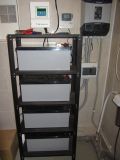
Backup power supply system on the lake. Seliger
System type: Backup power supply system with SB
Location: Tver region, Lake Seliger
Installation date: 2013
Overall rating: excellent.
Consumers: “Putin’s house.”
The system was installed in a new house, which the students of the All-Russian Youth Forum 2013 called “Putin’s house” (probably because the students themselves lived in tents in the forest). The system consists of a solar battery of 6 modules of 240 W each with a Prosolar SunStar SS-50C charge controller, a battery, and a Hybrid UPS with a maximum power of 4500 VA. Solar modules are installed on the wall with the ability to adjust the angle of inclination from 30 to 60 degrees.
The system provides backup power supply to one of the phases, as well as autonomous power supply during frequent interruptions in power supply from the network. If there is a network, the load is powered with priority for energy from.




Solar Photovoltaic Power Backup System
System type:
Location: Moscow region, Korolev
Installation date: 2013
Overall rating: excellent
Consumers: country house.
The system consists of a solar battery with a capacity of about 5 kW, a rechargeable battery, uninterruptible power supplies Studer Xtender XTH-6000, and a network photovoltaic inverter SMA Sunny Boy 5000-TL.
The system works in conjunction with the network and ensures uninterrupted power supply to consumers in the house. 1st phase is reserved. Network inverters are connected to the output of the Xtender UPS, which improves the efficiency of the system during the daytime. The system provides automatic start of the backup generator and is equipped with a subsystem for monitoring the condition of batteries (24*2V 1000A*h) Studer BSP-1200.




Backup power supply system with solar panels and automatic generator start
System type: Backup power system with generator
Location: Moscow region, Noginsky district
Installation date: 2013
Overall rating: excellent.
Consumers: country house.
The system consists of a solar battery with a Prosolar SunStar SS-50C charge controller, a battery, a Studer Xtender XTM-4000 power supply unit with a maximum power of 4000 VA, equipped with an automatic diesel generator start system. A diesel generator is used as an additional backup energy source. The diesel generator has been modified and equipped with an automatic start and stop system depending on the battery voltage. The equipment is installed in a utility room next to the house, the modules are on the roof of the house.
System type: Inexpensive off-grid power supply system with solar panels
Location: Moscow region
Installation date: 2013
Overall rating: excellent.
Consumers: dacha.
The system consists of solar panels with a charge controller, a battery, and a PNP7-24-2000 inverter. The equipment is installed in an electrical box. Later, the display panel was moved to the front door of the box.
![]()


System Type: Solar Power Backup System
Location: Moscow region
Installation date: 2012
Overall rating: excellent
Consumers: country house
The system consists of solar panels with a charge controller, two batteries, and an uninterruptible power supply unit MAP-Energy.



Solar Photovoltaic Power Backup System
System type:
Location: Perm
Installation date: 2012
Overall rating: excellent.
Consumers: residential building.
The system consists of a nearly 8 kW solar array, battery storage, Studer Xtender XTM-4000 uninterruptible power supplies and grid-tied photovoltaic inverters.
The system is 3-phase, works in conjunction with the network and ensures uninterrupted power supply to consumers in the house. All 3 phases are reserved. Network inverters are connected to the output of the Xtender UPS; if there is sufficient energy from the sun, the system is disconnected from the network and goes into completely autonomous mode. This allows you to save on energy costs and make the most of solar panels. Solar panels are installed on a detached garage. The system is also equipped with automatic start of the backup generator. The installation was carried out by a dealer in Perm, the TES-Perm company.




Solar Photovoltaic Power Backup System
System type:
Location: Moscow region
Installation date: 2012
Overall rating: good.
Consumers: country house.
The system consists of a solar battery with a power of about 7.5 kW, a 1000 A*h battery, Xtender XTH-5000 uninterruptible power supply units, Shneider Electric XW-MPPT80-600 solar panel controllers, and a Studer BSP-500 battery monitor.
The system works in conjunction with the network and ensures uninterrupted power supply to consumers in the house. 1 phase Xantrex MPPT is reserved. There is a limitation on power consumption from the network, so inverters have the ability to add power from batteries up to 10 kVA. If there is sufficient energy from the sun, the system disconnects from the network and goes into fully autonomous mode. This allows you to save on energy costs and make the most of solar panels. Solar panels are installed on a detached garage. The system is also equipped with automatic start of the backup generator.






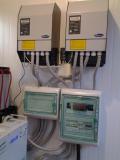

System type:
Location: Aprelevka, Moscow region
Installation date: 2011
Overall rating: excellent
Consumers: country house
The system consists of solar modules with a total power of 6 kW, 12 12 V batteries, 3 Xtender XTM-4000-48 uninterruptible power supply units, 3 Steca Grid-2000 network inverters.
The system works in conjunction with the network and ensures uninterrupted power supply to consumers in the house. All 3 phases are reserved. If there is sufficient energy from the sun, the system disconnects from the network and goes into fully autonomous mode. This allows you to save on energy costs and make the most of solar panels. Solar modules are mounted on the roof, which fits perfectly into the interior of the building.



Solar backup power supply system with increased power
System Type: Solar Power Backup System
Location: Kurgan
Installation date: 2011
Overall rating: excellent
Consumers: residential building
The system was installed by our client independently. Consists of 220W modules, 2 Outback Flexmax 60 controllers, batteries and Xtender XTH-6000 power supply unit. Solar modules provide most of the home's energy supply from spring to fall. This system is also used as a backup system and ensures long-term operation of consumers during network outages.

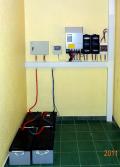
Solar backup power system with power addition
System type:
Location: Bolshakovo, Moscow region
Installation date: 2010
Overall rating: excellent.
Consumers: residential building.
The system consists of a solar battery with a power of about 1 kW, a rechargeable battery, and an Xtender 8000 uninterruptible power supply unit. Outback FlexMax 80 MPPT controller is used as a charge controller
The system works in conjunction with the network and ensures uninterrupted power supply to consumers in the house. The power supply scheme and settings ensure priority use of renewable energy sources. If solar panels produce energy to power the load in the house, consumption from the centralized power grid is reduced. Also, Xtender provides an increase in power of 8 kW, because... at the input from the networks there is a limitation of several kW. This solves the problem with peak loads in the house.



Grid-connected PV system 1 kW
Location: Moscow region
Installation date: 2010
Overall rating: excellent
Consumers: residential building
The system is installed on several cottages on Rublevskoye Highway. The developer's concept implies environmental friendliness of both accommodation and energy supply. Therefore, solar photovoltaic modules and grid-connected inverters were installed in all townhouses.
Each system consists of 6 solar modules with a total capacity of about 1 kW and Steca Grid 500 network inverters. The system is single-phase. All energy generated by solar panels is consumed in the house, thereby reducing consumption from the centralized power supply network.
Steca Grid 500 inverters provide power generation to the grid even in low light conditions. The grid receives “solar power” as soon as the solar panels can produce 2W of power! At the same time, the inverter has a built-in function for monitoring the maximum power of photovoltaic modules - in total, the solar battery is divided into 2 independent chains, for each of which the maximum power point is calculated separately. This prevents negative interference between parts of the solar battery when the modules are partially shaded (for example, by a cloud).

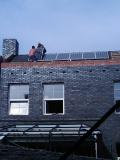

Solar backup power system
System type:
Location: Moscow region
Installation date: 2009
Overall rating: excellent
Consumers: residential building
The system consists of a solar battery with a power of about 0.5 kW, 12 batteries, and a Xantrex XW4548 uninterruptible power supply unit. The Xantrex XW MPPT 60 controller is used as a charge controller
The system works in conjunction with the network and ensures uninterrupted power supply to consumers in the house. The power supply scheme and settings ensure priority use of renewable energy sources. If solar panels produce energy to power the load in the house, consumption from the centralized power grid is reduced.


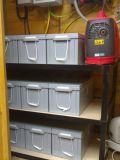
Wind-solar backup power supply system
System type: Backup uninterruptible power supply system with solar panels and wind turbine
Location: Samara region
Installation date: 2009
Overall rating: excellent.
Consumers: residential building.
The system consists of a solar battery with a power of about 4 kW, a wind-electric installation "Breeze-5000" with a power of 5 kW, a battery, and an uninterruptible power supply unit Xtender 8000. Outback FlexMax 80 MPPT controller is used as a charge controller
The system works in conjunction with the network and ensures uninterrupted power supply to consumers in the house. The power supply scheme and settings ensure priority use of renewable energy sources. If the solar panels and wind turbine generate enough energy to power the load in the home, the consumption from the district power grid stops. When the battery voltage drops below a preset value, power from the network is resumed automatically. This mode of priority use of energy from renewable sources is provided by Studer Xtender and SMA inverters.


Solar Photovoltaic Power Backup System
System type:
Location: Moscow region
Installation date: 2009
Overall rating: excellent.
Consumers: residential building.
The system consists of a solar battery with a power of about 2.5 kW, a rechargeable battery, and Xantrex XW 6048 uninterruptible power supply units.
The system works in conjunction with the network and ensures uninterrupted power supply to consumers in the house. All 3 phases are reserved. Xantrex MPPT MPPT controller is used as a charge controller


Solar Photovoltaic Power Backup System
System type:
Location: Sochi, Nizhnevysokoe village
Installation date: 2009
Overall rating: excellent.
Consumers: residential building.
The system consists of a solar battery with a power of about 2 kW, a battery, and Studer Xtender 6000 uninterruptible power supply units.
The network in the village is of extremely low quality - the voltage varies from 130 to 260 V, and there are frequent interruptions in power supply. The system works in conjunction with the network and ensures uninterrupted power supply to consumers in the house. One phase is reserved. There is a 12 kW stabilizer at the input. An Xantrex MPPT MPPT controller was used as a charge controller.
In the summer of 2009, the circuit breaker on the stabilizer tripped once, and the mains voltage was cut off. The owners of the house found out about this only a few days later by accident; all this time the house was supplied with energy from solar panels.

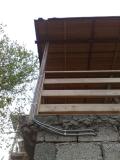




Grid-connected photovoltaic system
System type: Grid-connected photovoltaic system
Location: Moscow region
Installation date: 2008
Overall rating: excellent
Consumers: residential building
This system was the first grid-connected solar power supply system at the time of installation. The owner turned out to be “advanced” in technical terms and took our information about the advantages of network-connected systems and chose this type. There are no problems with the quality of electricity or power outages in the house. In case of interruptions there is a diesel electric generator.
The system consists of a solar battery with a power of about 3 kW and Steca Grid 500 network inverters. Steca Grid Control blocks perform the function of an RCD and a meter for electricity generated by solar panels. The system is three-phase, approximately 1 kW per phase. All energy generated by solar panels is consumed in the house.
Steca Grid 500 inverters provide power generation to the grid even in low light conditions. The grid receives “solar power” as soon as the solar panels can produce 2W of power! At the same time, the inverter has a built-in function for monitoring the maximum power of photovoltaic modules - in total, the solar battery is divided into 6 independent chains, for each of which the maximum power point is calculated separately. This prevents negative interference between parts of the solar battery when the modules are partially shaded (for example, by a cloud).
Since grid-tied inverters require a leading grid reference voltage to operate, in the event of a power outage this voltage is provided by a backup generator. Moreover, when the sun is shining, the fuel consumption of the electric generator is reduced. Thus, grid-tied inverters for solar panels allow you to save money even during interruptions in the power supply from the grid.
   |
Solar autonomous power supply system
Location: Moscow region, Dmitrovsky district
Installation date: 2009
Overall rating: excellent.
Consumers: residential building.
The system consists of a solar battery with a power of about 650 W with a charge controller, a battery, and a Sine inverter with a maximum power of 1700 VA (nominal about 1 kW). The equipment is installed in the utility room next to the house, the modules are on the roof of the terrace of the house.
The system operates completely autonomously and provides power to lighting and household loads within country house in the spring-autumn period. The load is energy-saving lamps, TV, refrigerator, power tools.
Solar autonomous power supply system
System type: Autonomous power supply system with solar panels for a country house
Location: Moscow region
Installation date: 2008
Overall rating: excellent.
Consumers: residential building.
The system consists of a solar panel with a power of about 120 W with a charge controller and a battery. The equipment is installed in a utility room in the house, the modules are mounted on the roof of the house.
The system operates completely autonomously and provides power to the lighting and household loads in a country house all year round . Loads include energy-saving lamps, TV, radio, and power tools.
 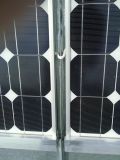    |
Solar autonomous power supply system
System type: Autonomous power supply system with solar panels
Location: Moscow region
Installation date: 2007
Overall rating: excellent.
Consumers: residential building.
The system consists of a solar battery with a power of about 340 W with a charge controller, a battery, a Sinus power supply unit with a maximum power of 3000 VA, equipped with an automatic diesel generator start system. A 5 kW diesel generator is used as an additional backup energy source. The diesel generator has been modified and equipped with an automatic start and stop system depending on the battery voltage. The equipment is installed in a utility room next to the house, the modules are on the roof of the house.
The system operates completely autonomously and provides power to the lighting and household loads in a country house in the spring and autumn. Loads include energy-saving lamps, TV, refrigerator, and power tools.
    |
Photos of our other objects
Below are photographs of some of our other facilities, without a description of the installed equipment

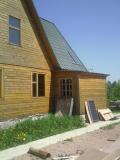




Autonomous solar power supply system
Using solar autonomous power plants for your home or garden:
- in cases where there is no external electricity to power household appliances and other equipment;
- during long power outages;
- with strong surges and sags in voltage.
Advantages of home solar power plants:
- solar power supply systems do not make noise or noise (unlike a gas generator);
- environmentally friendly;
- give the house a modern high-tech look;
- Save your energy budget.
Compound autonomous systems power supply:
- a set of solar panels for the home;
- "solar" charge controller;
- voltage inverter;
- Charger;
- energy storage devices - batteries.
Hybrid power supply system (solar + 220V)
Scope of application:
- To solve problems with frequent power outages at substations;
- To partially compensate for energy costs during the daytime;
- Area of application: houses and cottages with high daily consumption, offices, small agricultural enterprises.
Advantages:
- 220 Volt voltage available throughout the entire period of time;
- Instant response when external power supply is lost;
- Saving electricity received from the city power grid using solar energy.
Compound:
- Solar modules (batteries),
- Charge controller;
- Hybrid voltage inverter,
- Gel batteries or lithium rechargeable batteries.
Network solar power plants
Scope of application and purpose:
- Saving electricity received from external power grids by replacing it with energy obtained from solar panels;
- Network solar power plants are used at facilities with increased consumption electricity during the daytime.
Advantages:
- Eco-friendly source of electricity;
- Saving money on electricity received from city power grids;
- The system does not require maintenance, except for cleaning the surface of the solar modules.
Compound:
- solar panels
- network inverter.
2 year warranty from the date of installation.
Consultation, site visit to the customer and delivery of equipment free of charge! You will see a demonstration of the operation of the equipment at a stand in the company’s office.
